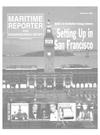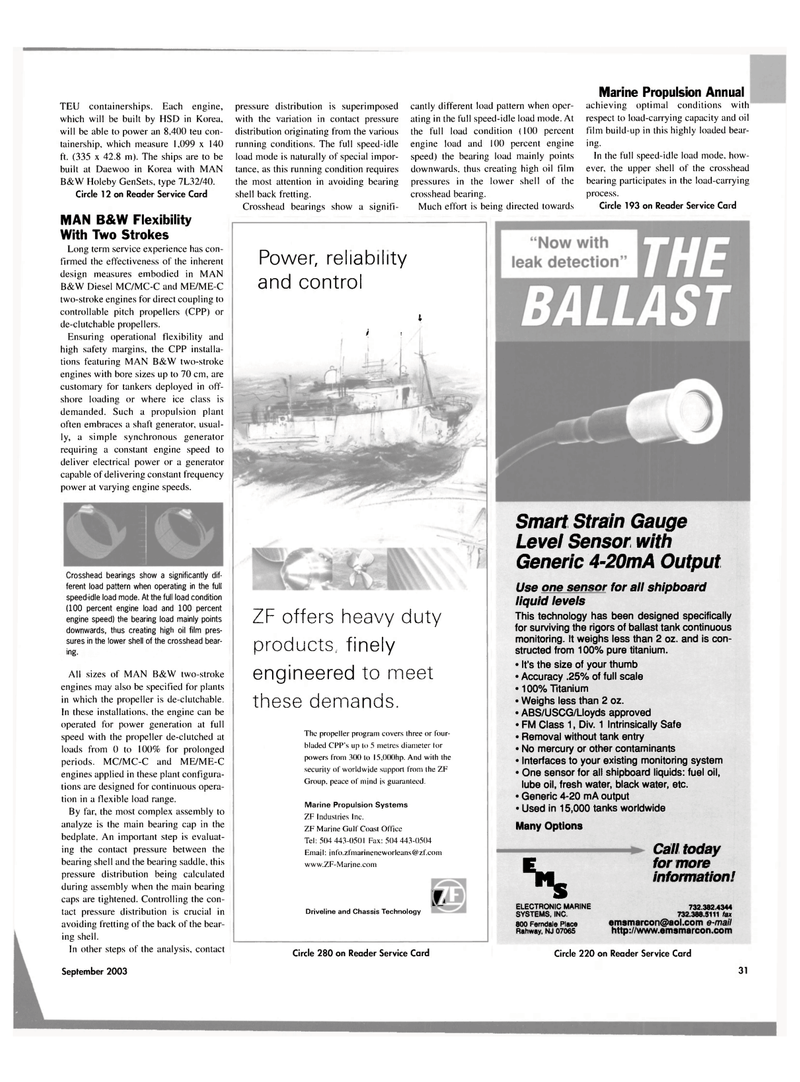
Page 31: of Maritime Reporter Magazine (September 2003)
Read this page in Pdf, Flash or Html5 edition of September 2003 Maritime Reporter Magazine
TEU containerships. Each engine, which will be built by HSD in Korea, will be able to power an 8,400 teu con- tainership, which measure 1,099 x 140 ft. (335 x 42.8 m). The ships are to be built at Daewoo in Korea with MAN
B&W Holeby GenSets, type 7L32/40.
Circle 12 on Reader Service Card
MAN B&W Flexibility
With Two Strokes
Long term service experience has con- firmed the effectiveness of the inherent design measures embodied in MAN
B&W Diesel MC/MC-C and ME/ME-C two-stroke engines for direct coupling to controllable pitch propellers (CPP) or de-clutchable propellers.
Ensuring operational flexibility and high safety margins, the CPP installa- tions featuring MAN B&W two-stroke engines with bore sizes up to 70 cm, are customary for tankers deployed in off- shore loading or where ice class is demanded. Such a propulsion plant often embraces a shaft generator, usual- ly, a simple synchronous generator requiring a constant engine speed to deliver electrical power or a generator capable of delivering constant frequency power at varying engine speeds.
Crosshead bearings show a significantly dif- ferent load pattern when operating in the full speed-idle load mode. At the full load condition (100 percent engine load and 100 percent engine speed) the bearing load mainly points downwards, thus creating high oil film pres- sures in the lower shell of the crosshead bear- ing.
All sizes of MAN B&W two-stroke engines may also be specified for plants in which the propeller is de-clutchable.
In these installations, the engine can be operated for power generation at full speed with the propeller de-clutched at loads from 0 to 100% for prolonged periods. MC/MC-C and ME/ME-C engines applied in these plant configura- tions are designed for continuous opera- tion in a flexible load range.
By far, the most complex assembly to analyze is the main bearing cap in the bedplate. An important step is evaluat- ing the contact pressure between the bearing shell and the bearing saddle, this pressure distribution being calculated during assembly when the main bearing caps are tightened. Controlling the con- tact pressure distribution is crucial in avoiding fretting of the back of the bear- ing shell.
In other steps of the analysis, contact
September 2003 pressure distribution is superimposed with the variation in contact pressure distribution originating from the various running conditions. The full speed-idle load mode is naturally of special impor- tance, as this running condition requires the most attention in avoiding bearing shell back fretting.
Crosshead bearings show a signifi- cantly different load pattern when oper- ating in the full speed-idle load mode. At the full load condition (100 percent engine load and 100 percent engine speed) the bearing load mainly points downwards, thus creating high oil film pressures in the lower shell of the crosshead bearing.
Much effort is being directed towards
J.
Marine Propulsion Annual achieving optimal conditions with respect to load-carrying capacity and oil film build-up in this highly loaded bear- ing.
In the full speed-idle load mode, how- ever, the upper shell of the crosshead bearing participates in the load-carrying process.
Circle 193 on Reader Service Card
Power, reliability and control 4 i i
ZF offers heavy duty products, finely engineered o meet these demands.
The propeller program covers three or four- bladed CPP's up to 5 metres diameter lor powers from 300 to I5,000hp. And with the security of worldwide support from the ZF
Group, peace of mind is guaranteed.
Marine Propulsion Systems
ZF Industries Inc.
ZF Marine Gulf Coast Office
Tel: 504 443-0501 Fax: 504 443-0504
Email: [email protected] www.ZF-Marine.com
Driveline and Chassis Technology
Circle 280 on Reader Service Card
Smart Strain Gauge
Level Sensor with
Generic 4-20mA Output
Use one sensor for all shipboard liquid levels
This technology has been designed specifically for surviving the rigors of ballast tank continuous monitoring. It weighs less than 2 oz. and is con- structed from 100% pure titanium. • It's the size of your thumb • Accuracy .25% of full scale • 100% Titanium • Weighs less than 2 oz. • ABS/U SCG/Lloyds approved • FM Class 1, Div. 1 Intrinsically Safe • Removal without tank entry • No mercury or other contaminants • Interfaces to your existing monitoring system • One sensor for all shipboard liquids: fuel oil, lube oil, fresh water, black water, etc. • Generic 4-20 mA output • Used in 15,000 tanks worldwide
Many Options
S
ELECTRONIC MARINE
SYSTEMS. INC. 800 Ferndale Place
Rahway, NJ 07065
Call today for more information! 732.382.4344 732.388.5111 lax [email protected] e-mail http://www.emsmarcon.com
Circle 220 on Reader Service Card 31

 30
30

 32
32
